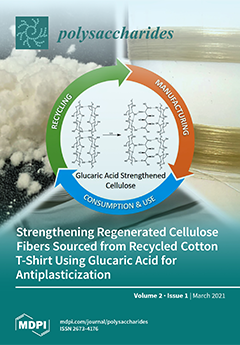Open AccessArticle
Chitosan-Based Adhesive: Optimization of Tensile Shear Strength in Dry and Wet Conditions
by
Maisa Abdelmoula, Hajer Ben Hlima, Frédéric Michalet, Gérard Bourduche, Jean-Yves Chavant, Alexis Gravier, Cédric Delattre, Michel Grédiac, Jean-Denis Mathias, Slim Abdelkafi, Philippe Michaud and Hélène de Baynast
Cited by 18 | Viewed by 4468
Abstract
Commercial adhesives present a high bond strength and water resistance, but they are considered non-healthier products. Chitosan can be considered as an interesting biosourced and biodegradable alternative, despite its low water resistance. Here, its wood bonding implementation and its tensile shear strength in
[...] Read more.
Commercial adhesives present a high bond strength and water resistance, but they are considered non-healthier products. Chitosan can be considered as an interesting biosourced and biodegradable alternative, despite its low water resistance. Here, its wood bonding implementation and its tensile shear strength in dry and wet conditions were investigated depending on its structural characteristics. Firstly, the spread rate, open assembly time, drying pressure, drying temperature, and drying time have been determined for two chitosans of European pine double lap specimens. An adhesive solution spread rate of 1000 g·m
−2, an open assembly time of 10 min, and a pressure temperature of 55 °C for 105 min led to a bond strength of 2.82 MPa. Secondly, a comparison between a high molecular weight/low deacetylation degree chitosan and a lower molecular weight/higher deacetylation degree chitosan was conducted. Tests were conducted with beech simple lap specimens in accordance with the implementation conditions and the conditioning treatments in wet and dry environments required for thermoplastic wood adhesive standards used in non-structural applications (EN 204 and EN 205). The results clearly revealed the dependence of adhesive properties and water resistance on the structural features of chitosans (molecular weight and deacetylation degree), explaining the heterogeneity of results published notably in this field.
Full article
►▼
Show Figures





